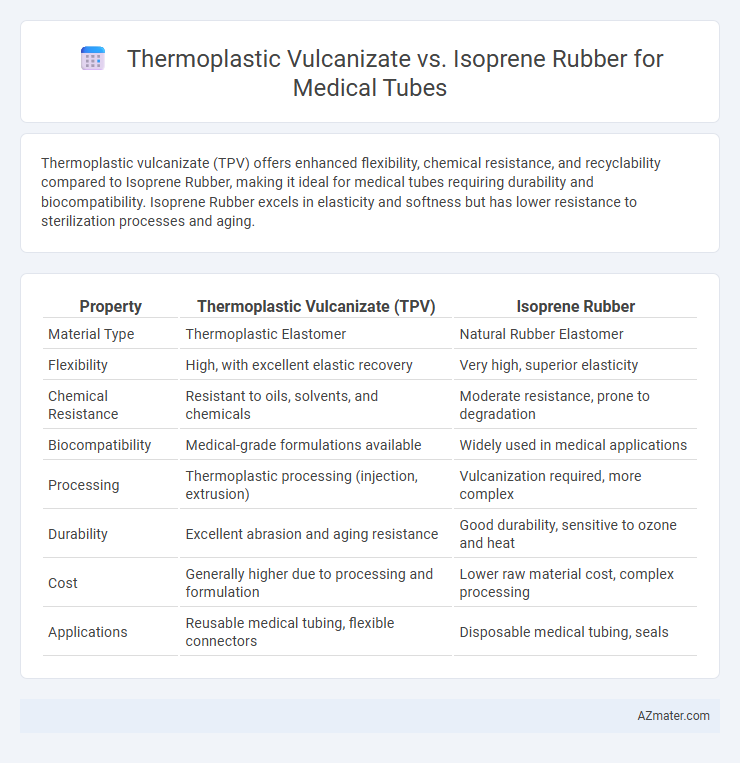Thermoplastic vulcanizate (TPV) offers enhanced flexibility, chemical resistance, and recyclability compared to Isoprene Rubber, making it ideal for medical tubes requiring durability and biocompatibility. Isoprene Rubber excels in elasticity and softness but has lower resistance to sterilization processes and aging.
Table of Comparison
| Property | Thermoplastic Vulcanizate (TPV) | Isoprene Rubber |
|---|---|---|
| Material Type | Thermoplastic Elastomer | Natural Rubber Elastomer |
| Flexibility | High, with excellent elastic recovery | Very high, superior elasticity |
| Chemical Resistance | Resistant to oils, solvents, and chemicals | Moderate resistance, prone to degradation |
| Biocompatibility | Medical-grade formulations available | Widely used in medical applications |
| Processing | Thermoplastic processing (injection, extrusion) | Vulcanization required, more complex |
| Durability | Excellent abrasion and aging resistance | Good durability, sensitive to ozone and heat |
| Cost | Generally higher due to processing and formulation | Lower raw material cost, complex processing |
| Applications | Reusable medical tubing, flexible connectors | Disposable medical tubing, seals |
Introduction to Medical Tubing Materials
Thermoplastic vulcanizate (TPV) and isoprene rubber are essential materials used in medical tubing due to their unique mechanical and chemical properties. TPV offers excellent flexibility, chemical resistance, and ease of processing, making it suitable for medical devices requiring sterilization and biocompatibility. Isoprene rubber provides superior elasticity, softness, and resilience, which are critical for applications involving patient comfort and dynamic fluid transfer in medical tubing.
Overview of Thermoplastic Vulcanizate (TPV)
Thermoplastic vulcanizate (TPV) is a unique class of elastomer that combines the flexible properties of rubber with the processability of thermoplastics, making it ideal for medical tubing applications requiring durability and biocompatibility. TPVs offer excellent chemical resistance, resistance to aging and fatigue, and superior flexibility, which ensures consistent performance in dynamic medical environments. Compared to Isoprene Rubber, TPV provides enhanced sterilization tolerance and easier recyclability, making it a preferred material in advanced medical tube manufacturing.
Understanding Isoprene Rubber (IR)
Isoprene Rubber (IR) exhibits excellent elasticity, biocompatibility, and chemical resistance, making it highly suitable for medical tubing applications requiring flexibility and patient safety. Its natural origin and hypoallergenic properties reduce the risk of irritation and adverse reactions during prolonged use. Compared to Thermoplastic Vulcanizate (TPV), IR offers superior tensile strength and resilience, ensuring durability in dynamic medical environments.
Mechanical Properties: TPV vs Isoprene Rubber
Thermoplastic vulcanizate (TPV) exhibits superior tensile strength and elongation compared to Isoprene Rubber, providing enhanced durability and flexibility for medical tubing applications. TPV offers higher resistance to compression set and better fatigue resistance, crucial for maintaining tube integrity under repetitive bending or pressure. Isoprene Rubber, while providing excellent elasticity and biocompatibility, tends to have lower mechanical resilience and faster degradation under mechanical stress than TPV.
Biocompatibility and Safety Considerations
Thermoplastic vulcanizate (TPV) offers superior biocompatibility and chemical resistance compared to isoprene rubber, making it more suitable for medical tubes exposed to bodily fluids and harsh sterilization processes. Isoprene rubber, while highly elastic and soft, may pose higher risks of allergic reactions and leachables due to natural latex proteins and additives. Safety considerations favor TPV for applications requiring prolonged patient contact and strict sterility standards in medical device manufacturing.
Flexibility and Durability in Medical Applications
Thermoplastic vulcanizate (TPV) offers superior flexibility and consistent elasticity, making it ideal for medical tubes that require repeated bending and manipulation without cracking. Isoprene rubber provides excellent initial elasticity and softness, yet it may degrade faster under sterilization processes, affecting long-term durability. In medical applications, TPV's enhanced chemical resistance and thermal stability ensure prolonged tube performance, while isoprene rubber suits applications demanding high softness but moderate durability.
Sterilization Compatibility
Thermoplastic vulcanizate (TPV) exhibits superior sterilization compatibility compared to isoprene rubber in medical tubing applications, withstanding multiple sterilization methods such as autoclaving, gamma radiation, and ethylene oxide without significant degradation. Isoprene rubber, while offering excellent elasticity and biocompatibility, often suffers from reduced mechanical properties and potential odor release when exposed to repeated sterilization cycles. The inherent thermoplastic nature of TPVs ensures better dimensional stability and resistance to chemical breakdown, making them more reliable for critical sterilization processes in medical environments.
Chemical Resistance and Fluid Interaction
Thermoplastic vulcanizate (TPV) offers superior chemical resistance compared to isoprene rubber, making it more suitable for medical tubes exposed to aggressive fluids and disinfectants such as alcohols, acids, and solvents. TPV maintains dimensional stability and prevents swelling or degradation when in contact with various medical fluids, ensuring longer service life and reliable performance. Isoprene rubber, while flexible and biocompatible, tends to absorb fluids and degrade faster under chemical exposure, limiting its application where chemical resistance is critical.
Cost-Effectiveness and Manufacturing Efficiency
Thermoplastic vulcanizate (TPV) offers superior cost-effectiveness for medical tube production due to its recyclability and reduced material waste compared to Isoprene Rubber. TPV enables faster manufacturing cycles through simultaneous vulcanization and shaping processes, enhancing production efficiency. Isoprene Rubber, while providing excellent elasticity, incurs higher costs in raw materials and post-curing steps, making TPV the preferred choice for large-scale, cost-sensitive medical tubing applications.
Conclusion: Selecting the Optimal Material for Medical Tubes
Thermoplastic vulcanizate (TPV) offers superior flexibility, chemical resistance, and ease of processing compared to isoprene rubber, making it highly suitable for medical tube applications requiring durability and biocompatibility. Isoprene rubber excels in elasticity and softness, providing excellent sealing capabilities but may fall short in long-term chemical stability and sterilization resilience. For medical tubes demanding repetitive sterilization, chemical exposure, and precise mechanical properties, TPV is the optimal choice, balancing performance and manufacturability effectively.

Infographic: Thermoplastic vulcanizate vs Isoprene Rubber for Medical Tube
 azmater.com
azmater.com